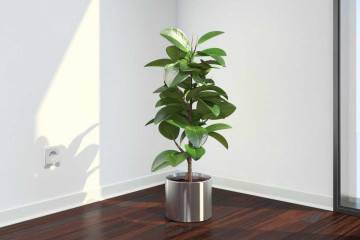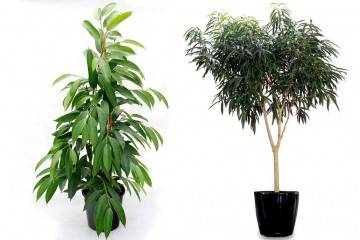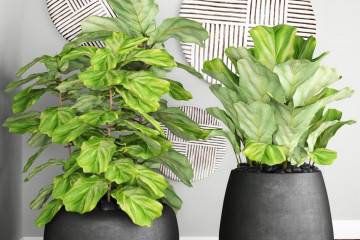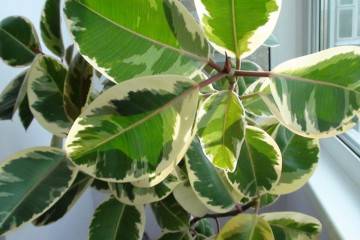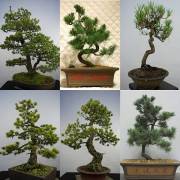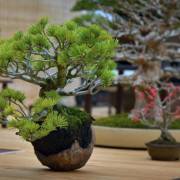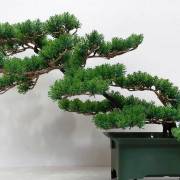Ficus bonsai - care and cultivation at home
Content:
Dwarf ficuses are used to create small decorative trees. The cultivation of bonsai from ficus was previously practiced in Asian countries, then the culture of plant formation reached Europe. The secrets of Japanese flower growers have long been revealed, miniature ficuses can be seen in many apartments.
What is Bonsai?
The Chinese have been engaged in the art of forming ornamental trees for more than 1000 years, they are the leaders. Later, Japanese monks took up the formation of domestic plants, and they were very successful in this. They came up with the word "bonsai", which means "plant on a tray." Ficus bonsai is prized for its fast growth, ease of formation. It does not take 30-50 years to create it, the tree will be formed much earlier.
Suitable types of ficus
Any variety is used for cultivation. There are magnificent miniature trees in the botanical gardens. For apartments, it is customary to use dwarf varieties with decorative leaves.
Ficus Microcarpa bonsai is a spectacular houseplant with a thickened grayish trunk, a cap of small oval leaves. In the wild, ficus grows in the tropical forests of Southeast Asia, the southern provinces of China, on the Australian continent. This plant parasitizes the roots of other trees. Several dwarf indoor species have been bred, growing up to 40 cm in height.
Ficus Benjamin bonsai is easily recognizable by its pointed leaves, which have a monochromatic or variegated color. Under natural conditions, the plant grows up to 25 meters. The height of the dwarf species is 60 cm. Breeders have bred several varieties of Benjamin, in which the leaf length varies from 4 to 12 cm. There are varieties with yellow and white strokes on smooth leaves, and some species have a contrasting outline.
Ficus Ginseng bonsai has another name - ginseng. The roots of the plant form tuberous outgrowths, shaped like the root system of ginseng. Leaves are oval with a sharp process at the tip.
Choosing a tree shape
A sapling can be grown to form all parts of the plant. The future shape of the bonsai depends on:
- species of plant;
- choosing a support stone for the roots;
- method of trimming.
It takes years and a lot of patience to create a bonsai.
How to shape a ficus tree like a bonsai
They start with the root system. The shoots are regularly shortened, aerial roots are removed until the root part of the trunk grows to the desired thickness. Only after that they begin to form the crown and trunk.
The crown is pruned twice a year from the top and sides. First, only the upper part of the crown is shortened, spreading side branches are achieved. Then they begin to create the desired shape. Cut off the shoot for 2-3 leaves, no more. Pruning is carried out after the appearance of 5-6 new leaves.
The barrel is attached to a support or stand gently with wire. It is carefully cut when the plant “remembers” the required shape. To create an inclined tree, the crown is tied to the bottom of the trunk or roots.
Pot and soil requirements
For ficus bonsai, a special pot is purchased - a pallet with low sides and legs up to 15 mm long. There should be holes at the bottom of the container to drain excess liquid.
Fertile soil is chosen for ficus. In flower shops, they purchase a special substrate with vermiculite, which retains moisture in the soil. The ready-made potting soil has a balanced composition, it has the necessary macronutrients.
Landing
Petioles up to 20 cm in length are cut from a dwarf ficus, they are placed in warm water, a few drops of a growth stimulant are added. The shoot should have at least 4 leaves and two points of growth.
After the roots appear, the cutting is transplanted into a tall pot. A stone is laid in the center, the roots are spread on it evenly.
After two to three years of growth, the plant is transplanted into a bowl pot, freeing up part of the root system. The exposure of the roots is carried out in stages, once every six months. With a strong one-time release, the rhizomes will bend strongly, the plant may die.
A net is laid at the bottom of the planting flesh pot, and it is covered with sand or fine gravel on top. Ficus is laid on top on the substrate.
Start to release the upper part of the roots.
Crown formation and pruning
Bonsai are pruned in stages, the interfering processes of aerial roots, the lower branches extending from the trunk are removed.
How to make a beautiful crown
With regular formative pruning (it is carried out twice a year), the crown thickens, begins to grow in width, and not in height.
Care
The tree requires regular watering, pruning, feeding. You need to take care of him, without rearranging from place to place.
Temperature
For plant growth, the optimal mode is 18-25 degrees. When the temperature drops, root rot develops, and when the temperature rises, the ficus sheds its foliage.
Illumination
In the winter season, ficus bonsai is illuminated with phytolamps, daylight hours are increased to 12 hours.
Watering
The soil is moistened as it dries. Watering is carried out using a jet from a watering can with a fine nozzle or a spray bottle. Use settled tap or filtered water.
Fertilizer use
For miniature trees, complex fertilizing for ficuses is used. Plants are fed during watering no more than once a month.
Diseases and pests
Ficus Microcarpa bonsai when caring for home should be examined. Insects are often found on thick roots. Trees with a dense crown lose their decorative effect with improper care.
Why Ficus Bonsai Sheds Leaves
The tree is prone to shedding foliage:
- after transplants;
- when rearranging to another place;
- when the earthen lump dries up.

It is necessary to fight the scabbard at the first signs of damage, young larvae instantly attack the leaves
Scabbard on ficus: signs of infection and treatment
Small sucking insects enter the plant in different ways:
- from other indoor plants;
- carried by the wind;
- get into the apartment on bouquets from flower shops.
The first signs: a sticky coating on the greenery and the trunk - honeydew. Then small growths appear on the bark of white, gray or brown color. Young scale insects are dangerous, they instantly creep all over the tree.
For treatment are used:
- anti-mite organophosphorus preparations;
- intestinal neonicotinoids;
- red pepper, sprinkled on the soil abundantly.
The treatment is carried out every 5 days until the honey pad disappears completely.
Why do ficus leaves turn yellow and fall
In a draft near the tree, foliage begins to fall off all over the crown. In the sun, baldness occurs only on the illuminated side.
The small trees are very beautiful. A novice florist will cope with the formation of Benjamin bonsai ficus with his own hands. If you wish, you can make an ornamental plant from other dwarf species of ficus.






